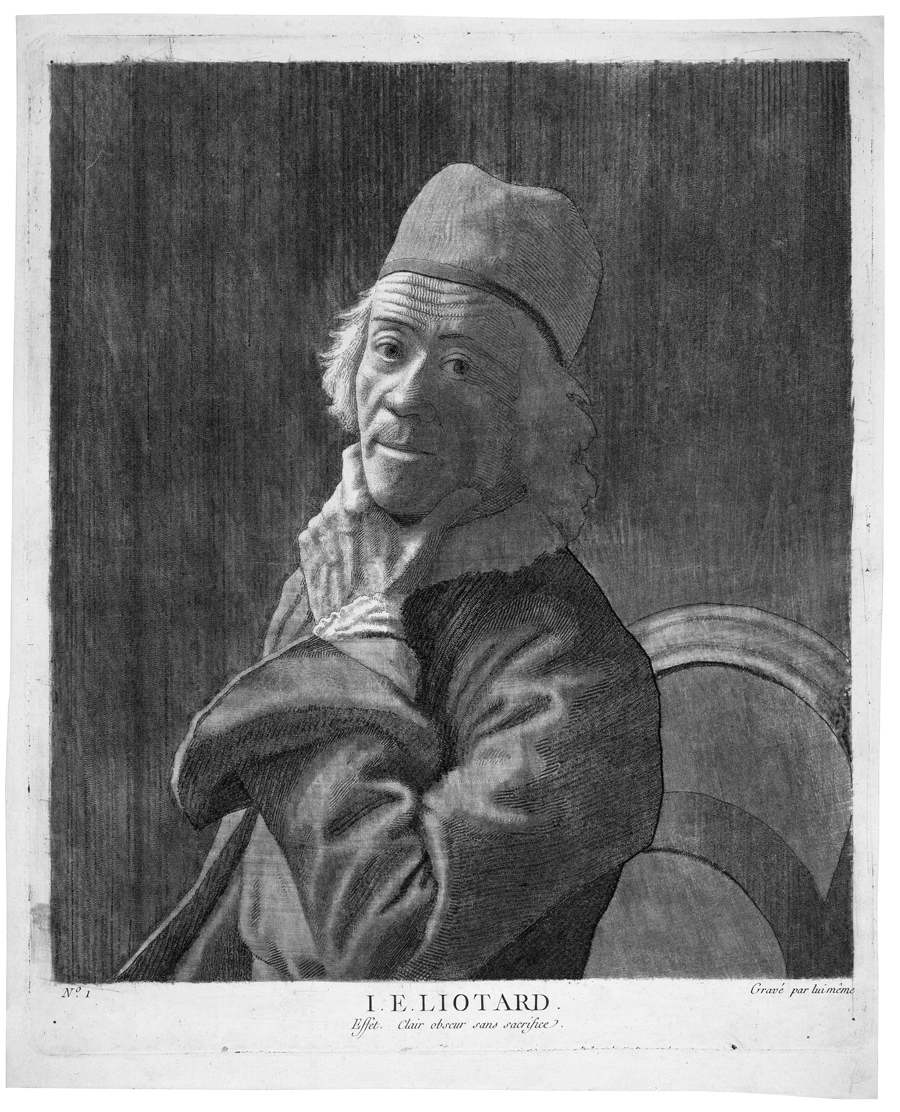Loading the page ...
Jean Etienne Liotard
(1702–1789, Geneva)
Large Self-portrait. Mezzotint, burin and roulette. 48 x 38.5 cm. Circa 1780. Tilanus 8; Roethlisberger/Loche 522.
This wonderfully pensive and introverted self-portrait dates from Liotard’s late period. The wrinkled brow of the old man, his thinning white hair and the bony hand bear sober, almost detached witness to the artist’s advanced age. Liotard’s questioning gaze is directed straight at the observer, while the pose of the hand suggests meditative reflection. It almost seems as though the artist had been disturbed by an unexpected visitor in a private moment of self-reflection.
Liotard was one of the most gifted and unconventional portraitists of the 18th century. His portraits, most of which are pastels, owe their charm to the unique spontaneity of their approach and a sometimes almost uncanny closeness to life, which lends the subject a universal, timeless presence. Although Liotard’s uncompromising, painstaking sense of reality was seen by several of his contemporaries as pedantic and shallow, he was in his lifetime an extraordinarily sought-after and well-paid portrait artist. He worked in Constantinople and in such important European art centres as Paris, Rome, London and Vienna, where he attained great esteem as an artist.
Liotard’s printed œuvre, on the other hand, was barely acknowledged either by his contemporaries or subsequent generations. It was not until 1897 that J. W. R. Tilanus compiled the first comprehensive scholarly catalogue of his graphic work, which numbers 17 prints. Almost without exception they have great rarity value, some of them being unique even. Furthermore, most of these prints were only published in small editions by the artist himself. No posthumous impressions are known to exist, as the copperplates were evidently lost early on.
The Large Self-portrait is undisputedly Liotard’s masterpiece.The portrayal is based on two works by the artist – a pastel and a charcoal drawing heightened with colour – that probably arose between 1770 and 1773 and are today to be found in Geneva’s Musée d’Art et d’Histoire. A smaller version of the self-portrait also done by the artist (Tilanus 9; Roethlisberger/Loche 523, see ill.) was used as an illustration to Liotard’s treatise Du Clair-obscur, which was published in 1781, thus giving us the terminus ante quem for the dating of this print, which may therefore plausibly be assumed to have been produced between 1778 and 1780. Quite apart from its unconventional self-portrayal, the Large Self-portrait is also amazing from a technical point of view. The innovative technique by which Liotard reworked a background done in mezzotint using a burin, roulette, scraper and other instruments was completely experimental in character. Liotard’s real purpose is not so much the creation of a grand scale of subtly gradated tonal values as the rendering of the soft light that illuminates the left half of the artist’s face and hand. Using various types of toothed tools he drew deep vertical furrows in the copperplate and created unconventional hatching patterns of great ornamental charm. As a printmaker Liotard was to some extent a dilettante, the rudimentary power of his technique constituting a very marked contrast to the work of contemporary English engravers, who raised the mezzotint technique to the highest degree of perfection. Nevertheless, it is the absolute originality of approach that makes Liotard’s Self-portrait a true masterpiece of European printmaking.
A superb, richly differentiated and tonal impression with margins around the platemark. An unobtrusive, smoothened drying fold on the verso, minor ageing, otherwise in excellent condition. The present proof is in all probability that from the Collection of C. B. Tilanus, which together with other drawings and prints by the artist’s was auctioned in Amsterdam in 1934. This important ensemble of works by Liotard had passed directly to C. B. Tilanus from the possession of the artist’s family (see sale catalogue Catalogus van den kostbaren luxueuzen Inboedel … Prof. Dr. C.B. Tilanus, October 23rd, 1934, C.W.L. Zwaal, Amsterdam, Nr. 1042).
